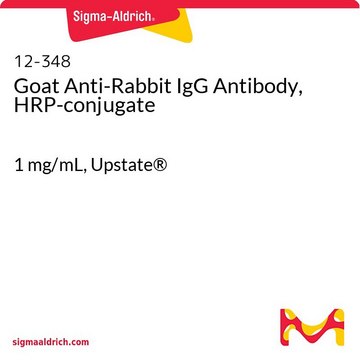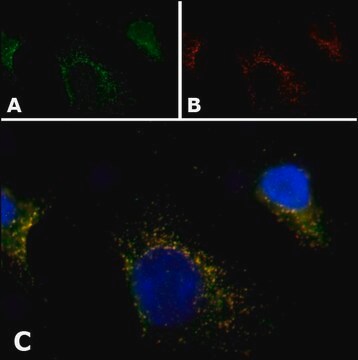400051
Hygromycin B
from Streptomyces sp., >85% (HPLC), liquid, aminoglycoside antibiotic, Calbiochem®
Synonym(s):
Hygromycin B, Streptomyces sp.
About This Item
Recommended Products
Product Name
Hygromycin B, Streptomyces sp., Unique aminoglycoside antibiotic that inhibits the growth of prokaryotic (bacteria) and eukaryotic microorganisms (yeasts) and mammalian cells.
Quality Level
Assay
>85% (HPLC)
form
liquid
manufacturer/tradename
Calbiochem®
storage condition
OK to freeze
color
amber to brown
shipped in
ambient
storage temp.
2-8°C
SMILES string
N([C@@H]1[C@H]([C@@H]([C@H]([C@@H](C1)N)O)O[C@@H]2O[C@@H]([C@@H]([C@@H]3OC4(O[C@@H]32)O[C@@H]([C@@H]([C@H]([C@H]4O)O)O)[C@@H](N)CO)O)CO)O)C
InChI
1S/C20H37N3O13/c1-23-7-2-5(21)9(26)15(10(7)27)33-19-17-16(11(28)8(4-25)32-19)35-20(36-17)18(31)13(30)12(29)14(34-20)6(22)3-24/h5-19,23-31H,2-4,21-22H2,1H3/t5-,6+,7+,8-,9+,10-,11+,12-,13-,14-,15-,16+,17+,18-,19+,20?/m1/s1
InChI key
GRRNUXAQVGOGFE-KPBUCVLVSA-N
General description
Resistance to Hygromycin B is conferred by a gene coding for a phosphotransferase that phosphorylates Hygromycin B, thereby inactivating it (Bilang, R., et al., Malpartida, F., et al.). Hygromycin B is known to selectively penetrate cells that have been rendered permeable by virus infection. This, combined with its potency in inhibiting translation, makes it an effective antiviral agent (MacIntyre, G., et al., Zhou, J., et al.).
The analytical data listed below will vary from lot to lot.
Bioassay: 350-450 U/mg
Concentration: 444,600 U/ml; 394 mg Hygromycin B/ml
Density: 1140-1155 mg/ml
% solids: 34.6%
Fill volumes:
100,000 U = 225 µl
1,000,000 U = 2.25 ml
10,000,000 U = 22.5 ml
250,000 U = 562 µl
5,000,000 U = 11.25 ml
Biochem/physiol Actions
growth of prokaryotic (bacteria) and eukaryotic microorganisms (yeasts) and mammalian cells
protein synthesis at the translocation step on the 70S ribosome and causes misreading of the mRNA
Warning
Reconstitution
Note: This product is highly toxic. Read enclosed MSDS before handling.
Other Notes
Hamada, W., et al. 1994. Curr. Genetics 26, 251.
Hubbard, S. C., et al. 1994. J. Biol. Chem.269, 3717.
Rikkerink, E. H., et al. 1994. Current Genetics25, 202.
Sugimoto, K., et al. 1994. Plant J.5, 863.
Buchschacher, G.L., Jr., and Panganiban, A.T. 1992. J. Virol.66, 2731.
Gaken, J., et al. 1992. Biotechniques13, 32.
Lama, J., and Carrasco, L. 1992. J. Biol. Chem. 267, 15932.
Ma, H., et al. 1992. Gene117, 161.
MacIntyre, G., et al. 1992. Adv. Exp. Med. Biol.276, 67.
Norman, J.A., et al. 1992. Mol. Pharmacol.41, 53.
Bilang, R., et al. 1991. Gene100, 247.
Dale, E., and Ow, D. 1991. Proc. Natl. Acad. Sci. USA88, 10558.
Lee, M.G-S., and Van der Ploeg, L. 1991. Gene105, 255.
Leslie, J.F., and Dickman, M.B. 1991. Applied Environ. Microbiol.57, 1423.
MacIntyre, G., et al. 1991. Antimicrob. Agents Chemother.35, 2125.
Zhou, J., et al. 1991. Gene107, 307.
Bulte, L., and Bennoun, P. 1990. Current Genetics18, 155.
Giordano, T.J., and McAllister, W.T. 1990. Gene88, 285.
Salauze, D., et al. 1990. Antimicrob. Agents Chemother.24, 1915.
Carrasco, L., et al. 1989. Pharmacol. Ther.9, 311.
Crespi, C.L., et al. 1989. Carcinogenesis10, 295.
Damm, B., et al. 1989. Mol. Gen. Genetics217, 6.
Egelhoff, T.T., et al. 1989. Mol. Cell. Biol.9, 1965.
Kronstad, J.W., et al. 1989. Gene79, 97.
Perlin, D.S., et al. 1988. J. Biol. Chem.263, 118.
Cullen, D., et al. 1987. Gene57, 21.
Gonzalez, A., et al. 1978. Biochim. Biophys. Acta521, 459.
Malpartida, F., et al. 1983. Biochem. Biophys. Res. Commun.117, 6.
Rao, S.N., et al. 1983. Antimicrob. Agents Chemother.24, 689.
Legal Information
Signal Word
Danger
Hazard Statements
Precautionary Statements
Hazard Classifications
Acute Tox. 1 Inhalation - Acute Tox. 2 Dermal - Acute Tox. 2 Oral
Storage Class Code
6.1A - Combustible acute toxic Cat. 1 and 2 / very toxic hazardous materials
WGK
WGK 3
Certificates of Analysis (COA)
Search for Certificates of Analysis (COA) by entering the products Lot/Batch Number. Lot and Batch Numbers can be found on a product’s label following the words ‘Lot’ or ‘Batch’.
Already Own This Product?
Find documentation for the products that you have recently purchased in the Document Library.
Customers Also Viewed
Our team of scientists has experience in all areas of research including Life Science, Material Science, Chemical Synthesis, Chromatography, Analytical and many others.
Contact Technical Service



